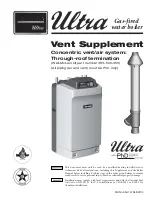
85
With the exception of the alarm contacts, external power must not be applied to any of the low voltage terminals - doing so
may damage the boiler control. Also note the following:
a) External Limit
- The external limit terminals are intended for use with a field supplied safety device, such as a manual
reset high limit. When an external limit is used, the jumper between these two terminals must be removed. Failure to
remove this jumper will render the external safety devices ineffective.
b) Alarm Contacts - These contacts close when the boiler enters a “hard” lockout (lockout requiring manual reset). They
may be used as an input to a building alarm system. Contact rating is 24VAC, 0.63FLA. Do not use for line voltage ap-
plications.
c) EnviraCOM - Used to connect EnviraCOM thermostat or other EnviraCOM device approved by the boiler manufacturer
for use with this boiler. A Honeywell EnviraCOM connection is also located as labeled on the boiler control itself.
d) Outdoor Sensor - Use only the Tasseron TSA00AA (10 KOhms) outdoor sensor supplied with the boiler. When this
sensor is connected and enabled, the boiler will adjust the target supply water temperature downwards as the outdoor
air temperature increases. This sensor should be located on the outside of the structure in an area where it will sense the
average air temperature around the house. Avoid placing this sensor in areas where it may be covered with ice or snow.
In general, locations where the sensor will pick up direct radiation from the sun should also be avoided. Avoid placing
the sensor near potential sources of electrical noise such as transformers, power lines, and fluorescent lighting. Wire the
sensor to the boiler using 22 gauge or larger wire. As with the sensor itself, the sensor wiring should be routed away from
sources of electrical noise. Where it is impossible to avoid such noise sources, wire the sensor using a 2 conductor, UL
Type CM, AWM Style 2092 shielded cable. Connect one end of the shielding on this cable to ground. See Section XII
“Operation” for information on enabling the outdoor reset sensor.
e) Header Sensor - When this sensor is installed and enabled, the boiler will attempt to maintain the target water
temperature in the header rather than in the supply. Where the system flow rate varies widely, the use of a header
sensor allows the temperature of the water being sent to the radiation to be more accurately controlled. Use sensor
P/N 103104-01 (Honeywell 32003971-003) with 1/2" NPT immersion well, P/N 80160456. Installation of this sensor in
a well, as opposed to on the surface of the header, is highly recommended. Alternatively use 1/2" NPT direct immersion
sensor, P/N 101935-01. Locate this sensor immediately downstream of the second primary-secondary Tee (Figure 10.4).
Use of a direct immersion sensor is also acceptable. The sensor wiring should be routed away from sources of electrical
noise. Where it is impossible to avoid such noise sources, wire the sensor using a 2 conductor, UL Type CM, AWM
Style 2092, 300Volt 60°C shielded cable. Connect one end of the shielding on this cable to ground. See Section XII
“Operation” for information on enabling the header sensor.
f) MODBUS - Boiler-To-Boiler communication network is used for multiple boiler (“Lead-Lag”) installations. See the
multiple boiler installation supplement for additional information.
X. Wiring
(continued)
CAUTION
When making low voltage connections, make sure that no external power source is present in the
thermostat or limit circuits. If such a power source is present, it could destroy the boiler’s control.
One example of an external power source that could be inadvertently connected to the low voltage
connections is a transformer in the old thermostat wiring.
Do not attempt to use EnviraCOM connections for any purpose not explicitly permitted by the boiler
manufacturer. Attempting to do so may result in unreliable operation and/or damage to controls.
Summary of Contents for Raptor RPTR085
Page 1: ...1...
Page 13: ...13 Figure 5 1 Wall Layout Mounting Hole Location V Mounting The Boiler continued...
Page 87: ...87 Figure 10 5 Internal Wiring Ladder Diagram X Wiring continued...
Page 88: ...88 X Wiring continued...
Page 97: ...97 Operating Instructions XI Start Up and Checkout continued...
Page 142: ...142 XV Repair Parts continued 3A 3B 3C 3D 3F 3E 3G 3H 3O 3P 3Q 3R 3J 3K 3I 3M 3N 3L All Models...
Page 148: ...148 XV Repair Parts continued 6D 6B 6A 6E 6I 6G 6L 6N 6H 6C 6K 6M 6C 6C 6J 6J 6F All Models...
Page 172: ...172...
















































